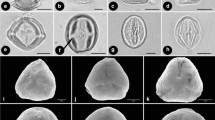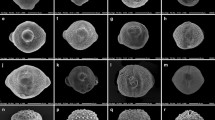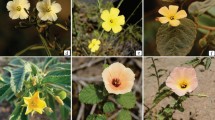Abstract
Smilacaceae are a small family of dioecious, mostly climbing, net-veined monocotyledons with a cosmopolitan distribution. Relatively little is known about the variation of pollen morphology within the family. For this reason, and to investigate the systematic value of palynology in Smilacaceae, pollen from 125 species of Smilax, Heterosmilax, and Ripogonum was examined using light and scanning electron microscopy. Ten of these were examined further by transmission electron microscopy. Four distinct pollen types grouped into two major pollen classes were distinguished: Class 1, represented by the pollen of all Smilax and Heterosmilax species, is mostly spheroidal, inaperturate, and spinulate or microspinulate, with a thin, fragile exine of varied sculpturing; three pollen types are represented within this class. Class 2 is found only in Ripogonum and contains a single pollen type with prolate, monosulcate, reticulately-sculptured pollen. The unique pollen morphology of Ripogonum supports its removal from Smilacaceae. In contrast, the characteristics of Heterosmilax pollen intergrade with those seen in Smilax, suggesting that the former might be better reduced to synonymy with the latter. A key to the identification of these pollen types is presented along with a discussion of geographic and possible evolutionary trends among them.
Similar content being viewed by others
References
R. H. P. Andreata (1995) Revisão das espécies brasileiras do gênero Smilax Linnaeus (Smilacaceae) Doctoral dissertation, Instituto de Biociências da Universidade de São Paulo Brazil
Cameron K. M., Fu C. X. (2006) A nuclear rDNA phylogeny of Smilax (Smilacaceae). Final Proc. Monocots Conf., Los Angeles. (in press).
Chase M. W., Duvall M. R., Hills H. G., Conran J. G., Cox A. V., Eguiarte L. E., Hartwell J., Fay M. F., Caddick L. R., Cameron K. M., Hoot S. (1995) Molecular phylogenetics of Liliana. In: Rudall P. J., Cribb P. J., Cutler D. F., Humphries C. J. (eds.) Monocotyledons: systematics and evolution. Vol. 1. Royal Botanic Gardens Kew, pp. 109–137.
M. W. Chase D. E. Soltis P. S. Soltis P. J. Rudall M. F. Fay W. H. Hahn S. Sullivan J. Joseph T. J. Givinish K. J. Systma J. C. Pires (2000) Higher-level systematics of the monocotyledons: an assessment of current knowledge and a new classification K. L. Wilson D. A. Morrison (Eds) Monocots: systematics and evolution CSIRO Collingwood, Victoria 3–16
S. C. Chen T. Koyama S. Y. Liang (2000) Smilax, Heterosmilax Z. Y. Wu P. H. Raven (Eds) Flora of China. Vol. 24 Science Press, Beijing & Missouri Botanical Garden Press St. Louis 96–117
S. C. Chen Y. X. Qiu A. L. Wang C. X. Fu (2006) ArticleTitleA phylogenetic analysis of the Smilacaceae based on morphological data Acta phytotaxonomica Sinica. 14 IssueID2 113–125 Occurrence Handle10.1360/aps050065
J. G. Conran H. T. Clifford (1985) ArticleTitleThe taxonomic affinities of the genus Ripogonum Nordic Jour. Bot. 5 215–219 Occurrence Handle10.1111/j.1756-1051.1985.tb01650.x
J. G. Conran (1989) ArticleTitleCladistic analyses of some net-veined Liliiflorae Pl. Syst. Evol. 168 123–141 Occurrence Handle10.1007/BF00936093
J. G. Conran (1998) Smilacaceae K. Kubitzki (Eds) The Families and Genera of Vascular Plants. Vol. 3. Flowering Plants. Monocotyledons: Lilianae (except Orchidaceae) Springer Berlin 417–422
L. M. Cranwell (1953) ArticleTitleNew Zealand pollen studies: the monocotyledons Bull. Auckland Inst. Mus. 3 1–91
Cronquist A. (1981) An Integrated System of classification of Flowering Plants. Columbia Univ. Press, New York, pp. 1262–1263.
Cronquist A. (1988) The evolution and classification of flowering plants, 2nd edn. New York Bot. Gard., Boston, p. 555.
R. M. T. Dahlgren (1975) ArticleTitleA system of classification of the angiosperms to be used to demonstrate the distribution of characters Bot. Not. 128 119–147
R. M. T. Dahlgren H.T. Clifford P. F. Yeo (1985) The Families of the Monocotyledons: Structure, Evolution and Taxonomy Springer Berlin
G. Erdtman (1952) Pollen Morphology and Plant Taxonomy. Angiosperms Almqvist & Wiksell Stockholm
G. Erdtman (1960) ArticleTitleThe acetolysis method, a revised description Svensk. Bot. Tidskr. 54 561–564
C. A. Furness P. J. Rudall (1999) ArticleTitleInaperturate pollen in monocotyledons Int. J. Plant Sci. 160 IssueID2 395–414 Occurrence Handle10.1086/314129
Heusser C. J. (1971) Pollen and spores of Chile. University of Arizona Press, Tucson, p. 167.
V. H. Heywood D. M. Moore W. T. Stearn (1993) Flowering plants of the world. Updated edition Oxford Univ. Press New York
Holmes W. C. (2002) Smilacaceae. In: Flora of North America Edit. Committee (eds.) Flora of North America. Vol. 26. Oxford Univ. Press, New York
Holmgren P. K., Holmgren N. H., Barnett L. C. (1990) Index Herbariorum, part 1: the herbaria of the world. 8th edn. New York Botanical Garden, p. 693.
J. Hutchinson (1973) The families of flowering plants, 3rd edn Clarendon Press Oxford
W. S. Judd (1998) ArticleTitleThe Smilacaceae in the southeastern United States Harvard Pap. Bot. 3 147–169
W. S. Judd C. S. Campbell E. A. Kellogg P. F. Stevens (1999) Plant systematics: a Phylogenetic approach Sunderland Mass Sinauer
Kunth (1850) Enum. Pl. 5: 270.
T. Koyama (1960) ArticleTitleMaterials toward a monograph of the genus Smilax Quart. J. Taiwan Mus. 13 1–61
T. Koyama (1984) ArticleTitleA taxonomic revision of the genus Heterosmilax (Smilacaceae) Brittonia 36 184–205 Occurrence Handle10.2307/2806629
W. J. Kress D. E. Stone (1982) ArticleTitleNature of the sporoderm in monocotyledons, with special reference to the pollen grains of Canna and Heliconia Grana 21 129–148 Occurrence Handle10.1080/00173138209427690
Mabberley D. J. (1997) The Plant-book, 2nd edn. Cambridge, England, pp. 666–667.
J. Muller (1970) ArticleTitlePalynological evidence on early differentiation of angiosperms Biol. Rev. 45 417–450
E. Pacini G. G. Franchi (1983) Pollen grain development in Smilax aspera L. and possible functions of the loculus D. L. Mulcahy E. Ottaviano (Eds) Pollen biology and implications for plant breeding Elsevier Amsterdam 183–190
Punt W., Blackmore S., Nilsson S., Thomas L. A. (1994) Glossary of pollen and spore terminology. LPP Contrib. Ser. 1, LPP Found., Utrecht.
P. J. Rudall K. L. Stobart W. P. Hong J. G. Conran C. A. Furness G. C. Kite M. W. Chase (2000) Consider the lilies: systematics of Liliales K. L. Wilson D. A. Morrison (Eds) Monocots: systematics and evolution CSIRO Collingwood, Victoria 347–359
P. J. Rudall C. A. Furness (1997) ArticleTitleSystematics of Acorus: ovule and anther Int. J. Pl. Sci. 158 640–651 Occurrence Handle10.1086/297477
Schulze W. (1982a) Beiträge zur Taxonomie der Liliifloren VII. Philesiaceae. Wiss. Z. Friedrich Schiller Univ. Jena 31: 277–283.
Schulze W. (1982b) Beiträge zur Taxonomie der Liliifloren VIII. Smilacaceae. Wiss. Z. Friedrich Schiller Univ. Jena 31: 285–289.
Takhtajan A. L. (1987) Systema Magnoliophytorum (Sistema Magnoliogitov.). (in Russian). Leningrad, p. 438.
A. L. Takhtajan (1997) Diversity and classification of flowering Plants Columbia University Press New York
G. Thanikaimoni (1986) Pollen apertures: form and function S. Blackmore I. K. Ferguson (Eds) Pollen and spores: form and function Academic Press London 119–136
R. F. Thorne (1983) ArticleTitleProposed new realignments in the angiosperms Nordic J. Bot. 3 85–117 Occurrence Handle10.1111/j.1756-1051.1983.tb01447.x
A. Vinnersten K. Bremer (2001) ArticleTitleAge and biogeography of major clades in Liliales Amer. J. Bot. 88 1695–1703
A. Vinnersten G. Reeves (2003) ArticleTitlePhylogenetic relationships within Colchicaceae Amer. J. Bot. 90 1455–1462 Occurrence Handle1:CAS:528:DC%2BD3sXptVCiurs%3D
J. W. Walker (1974) ArticleTitleAperture evolution in the pollen of primitive angiosperms Amer. J. Bot. 61 1112–1136 Occurrence Handle10.2307/2441929
RP Wodehouse (1933) ArticleTitleTertiary pollen. II. The oil shales of the Eocene Green River formation Bull. Torrey Bort. Club. 60 479–524 Occurrence Handle10.2307/2480586
M. S. Zavada (1983) ArticleTitleComparative morphology of monocot pollen and evolutionary trends of apertures and wall structures Bot. Rev. 49 331–379
Author information
Authors and Affiliations
Corresponding authors
Rights and permissions
About this article
Cite this article
Chen, SC., Zhang, XP., Ni, SF. et al. The systematic value of pollen morphology in Smilacaceae. Plant Syst. Evol. 259, 19–37 (2006). https://doi.org/10.1007/s00606-006-0424-y
Received:
Accepted:
Published:
Issue Date:
DOI: https://doi.org/10.1007/s00606-006-0424-y




